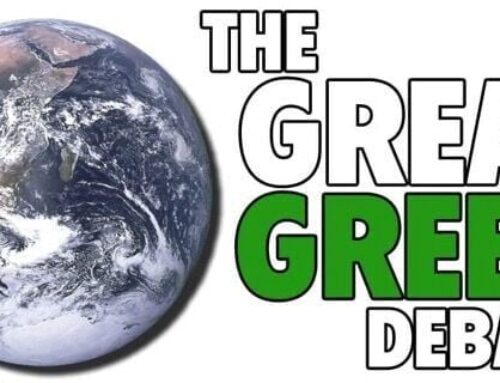Fashion Upcycling and the Human Right to a Healthy Environment: Trademark Protection Thwar
April 15, 2025
Trademark Protection Thwarting Sustainable Reuse?
With new collections each season, the fashion industry produces a highly problematic fashion garbage heap every year. Circular economy projects seeking to produce “new” garments by reworking second hand and unsold fashion items have particular societal value against this background. EU law explicitly recognizes the importance of environmental protection projects by stating in Article 37 of the Charter of Fundamental Rights that the improvement of the quality of the environment must be ensured in accordance with the principle of sustainable development. The Circular Economy Action Plan – adopted in 2020 by the European Commission as a pillar of the European Green Deal – offers additional support. An important element of the Action Plan is the objective to establish a legal framework that makes product policies more sustainable, in particular by enhancing the sustainability and repairability of goods in the European market.
Evidently, legal solutions that support fashion reuse have particular relevance in the light of these goals. Initiatives, such as fashion upcycling, add new value to worn pieces of clothing and contribute to the reduction of fashion waste. “Upcycling” can be defined as “the process of transforming by-products, waste materials, useless, or unwanted products into new materials or products perceived to be of greater quality, such as artistic value or environmental value.”
Trademark protection of brand insignia displayed on fashion items, however, can pose difficulties. The more garment components enjoy trademark protection, the more legal obstacles arise. Upcycling may trigger allegations of (post-sale) consumer confusion and unfair freeriding when fashion elements bearing third-party trademarks remain visible on “new” upcycled products made of fashion waste. To support the sustainable reuse of fashion items in the shadow of trademark protection, it thus is important to assure upcyclers that they can rework trademarked fashion items without risking infringement. Offering a reliable shield against trademark claims, EU law can provide legal certainty for fashion upcyclers and support the sustainable reuse of fashion products.
Weakness of existing defences
In principle, EU trademark law could achieve these goals by making robust defences available – defences which fashion upcyclers can invoke to neutralize infringement claims. As upcycling concerns the productive reuse of fashion items that have initially been produced and marketed by the trademark owner, the exhaustion of trademark rights after the first sale of products bearing brand insignia comes to mind. The crux, however, lies in the focus on the resale of goods in the specific form in which they have been marketed by the trademark owner. Product changes as a result of upcycling can render the exhaustion doctrine inapplicable. Article 15(2) of the EU Trade Mark Regulation stipulates that exhaustion shall not occur when the trademark owner has legitimate reasons to oppose further commercialisation, especially where the condition of the goods is changed or impaired after they have been put on the market. As upcycling entails changes, trademark owners will often have the opportunity to rebut exhaustion arguments in upcycling cases by pointing out that the condition of the goods has been changed or that elements of the original goods have become part of new and different, upcycled goods.
Not only the exhaustion doctrine but also other limitations of trademark rights may fail to offer sufficient flexibility. Article 14(1) of the EU Trade Mark Regulation explicitly permits so-called “referential use”: use “for the purpose of identifying or referring to goods or services as those of the proprietor of that trade mark.” For instance, a parody using a trademark to criticize policies of the trademark proprietor, or the mention of a trademark in a critical newspaper article, may fall within the scope of the referential use defence. Arguably, the display of trademarked fashion elements on circular economy products can also be regarded as a legitimate form of referential use. Fashion re-users refer to reworked fashion products as those of the trademark proprietor to make an important statement on the urgent need to change production and consumption patterns: sustainable reuse instead of wasteful new productions several times a year.
Considering current developments in EU trademark law and practice, however, it is doubtful whether the referential use defence will effectively shield users who invoke the HR2HE from the verdict of infringement. The Court of Justice of the EU (CJEU) may prefer a restrictive interpretation. The decision in Audi/GQ points in this direction. The case concerned the sale of spare parts for Audi models from the 1980s and 1990s. GQ offered grilles that contained an element designed for the attachment of the protected Audi emblem. Discussing whether the marketing of these Audi grilles could be regarded as a legitimate form of referential use, the CJEU held (at [57]) that no permissible referential use could be found when the alleged infringer incorporated a conflicting sign into spare parts intended for repair. A valid case of referential use could only be found when the alleged infringer, without affixing the third-party trademark to the spare parts themselves, merely used the trademark to indicate that they were compatible with the trademark owner’s cars.
Quite clearly, this restrictive interpretation can thwart the invocation of the referential use defence when the sign triggering the infringement action becomes an element of the product offered by the user invoking the defence. This approach can have a deep impact on reuse in the circular economy. It minimizes the chances of having success with referential use arguments when a third-party trademark remains visible on upcycled fashion products.
A comparison with developments in the area of descriptive use further darkens the horizon. Before the Audi decision, the CJEU already held that the descriptive use defence was inapplicable when a third-party trademark became a central element of the very contents of a product. In Adidas/Marca – a case about allegedly infringing use of decorative elements similar to Adidas’ famous three stripes logo – the Court concluded (at [48]) that the use of a two-stripe motif on sports clothing was “not intended to give an indication concerning one of the characteristics of those goods.” If a trademarked design element remains visible on an upcycled product, the upcycler will thus have difficulty to argue that this indicates a product characteristic – namely the fact that the product is the result of reworking used garments. Similarly, the Court denied descriptive use in Opel/Autec, at [44], on the ground that the faithful reproduction of the Opel logo on a scale model car could not be regarded as an indication of product characteristics. Instead, the logo became part of the product itself. This CJEU case law does not give much hope that defences in trademark law, such as the defences for referential and descriptive use, will be applied broadly.
Honest practices test as an additional obstacle
EU trademark legislation itself poses additional hurdles. Article 14(2) of the Trade Mark Regulation makes the invocation of limitations of exclusive trademark rights that can serve as defences for upcyclers dependent on compliance with honest practices in industrial or commercial matters. This additional, open-ended prerequisite can cause substantial difficulties. The CJEU tends to determine compliance with honesty in industrial and commercial matters on the basis of the same criteria that inform the analysis of prima facie infringement in trademark confusion and dilution cases. This circular approach has led to concerns that the inquiry into honest practices may ignore competing societal values underpinning the limitations of trademark rights. Instead of shaping the honest practices test in a way that offers room for competing policy objectives, the CJEU simply replicates standard criteria of the trademark infringement analysis. In Gillette, for instance, the Court held (at [49]) that use would fail to comply with honest practices in industrial and commercial matters if it gave the impression that there was a commercial connection between the third party and the trademark owner (=causing confusion), or affected the value of the trademark by taking unfair advantage of its distinctive character or repute (=unfair freeriding).
As indicated, these criteria for rejecting defences that upcyclers might invoke, replicate infringement criteria in the field of trademark protection against confusion and dilution. The risk of circularity is obvious: by copying almost literally the criteria for establishing prima facie infringement, the CJEU subjects defences to additional scrutiny in the light of the same criteria that enabled the trademark owner to bring the infringement claim in the first place. As a result, defence arguments, such as referential use, become moot in practice. Following the current CJEU approach, the same findings that have led to a finding of prima facie infringement in upcycling cases support the denial of compliance with honest practices when the upcycler invokes defences. The symmetry of criteria for assessing prima facie infringement and determining honesty in industrial and commercial matters can easily lead to a situation where a finding of a likelihood of confusion or unfair freeriding already foreshadows a finding of dishonest practices and a rejection of defence arguments.
In sum, the conclusion seems inescapable that current EU trademark legislation fails to offer legal certainty for upcycling projects. Instead, trademark infringement claims are risk factors that can easily discourage upcyclers seeking to reduce fashion waste.
Ways out of the dilemma
So what should be done?
Considering the environmental crisis – fuelled by the wasteful use of resources in the fashion industry (see Eva Meyermans Spelmans’s previous post in this symposium here) – it is of particular importance to develop legal solutions that offer upcyclers a high degree of legal certainty even when they rework fashion items that bear third-party trademarks. As both the exhaustion doctrine and statutory defences, as demonstrated, fail to offer a sufficient degree of legal certainty in EU trademark law, it is important to explore alternative avenues to support sustainable reuse. To give fashion upcycling a chance, a legal presumption of non-infringing, permissible use should be introduced. More concretely, it should be assumed that consumers are well aware that trademarked fashion pieces may be reworked and included in circular economy products. Third-party trademarks that remain visible as a result of upcycling may be reminiscent of the original fashion items that served as raw materials. Considering the overarching goal of environmental protection, however, the assessment must be based on the perception of an average consumer who knows about the sustainable reuse of fashion items and looks actively for indications of commercial origin which upcyclers add to ensure transparency.
Hence, it should be clarified in EU trademark law that, by affixing their own logos to upcycled products, fashion re-users can dispel concerns about (post-sale) confusion, and avoid a finding of blurring, tarnishment or unfair freeriding. Seeing the upcycler’s logo, the well-informed consumer will understand that third-party trademarks have become decorative elements of a “new” product consisting of reworked fashion items that served as raw materials. This finding should tip the scales in favour of the upcycler and, as a rule, exclude trademark infringement claims. The trademark proprietor should only be able to rebut the presumption of permissible use by producing evidence that the circular economy setting is a mere pretext for a use specifically intended to mislead consumers or unfairly profit from the magnetism of the third-party brand.
Search
RECENT PRESS RELEASES
Related Post




